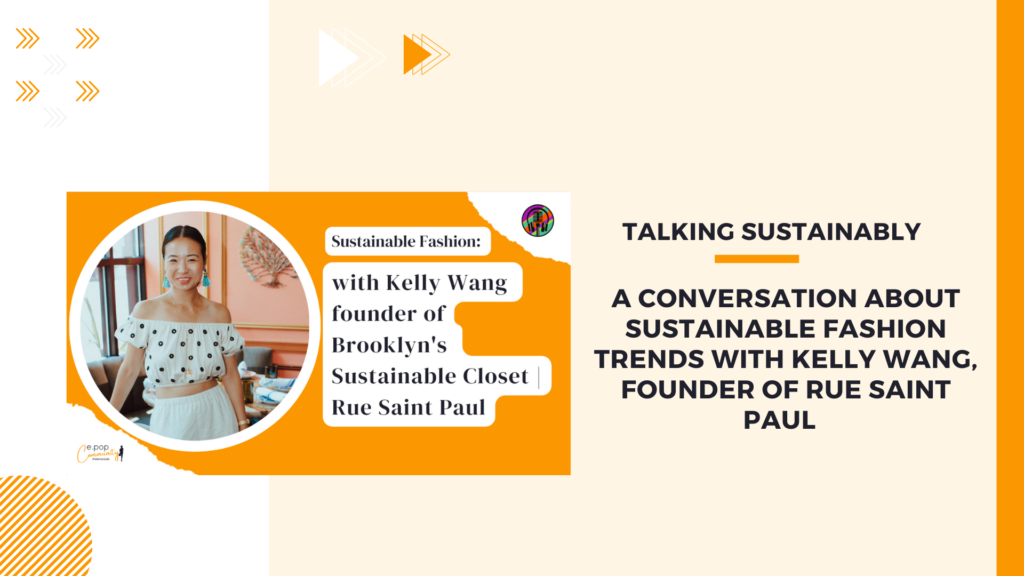It was tough for everyone but some small businesses got a little extra creative to keep their businesses running when face-to-face was not an option. Check out what Kelly, Brooklyn retail store owner, did to keep her customers happy and shopping!
In this webinar Q&A with Kelly Wang, founder & owner of the sustainable retail store, Rue Saint Paul, we discuss:
- Striving for low impact over no impact
- Trends in sustainable fashion
- Tips to survive covid-19 as a small business
Watch the webinar below or on our youtube channel.
About Rue Saint Paul
Rue Saint Paul (RSP) is a sustainable collective, marketplace, and concept closet connecting sustainably and ethically conscious designers with New York communities. Located in Brooklyn, New York, this boutique store sells unique pieces and brings the community together by promoting local and international skills and innovation.
About Talking Sustainability
Sustainability can be daunting, overwhelming, and full of jargon. Talking Sustainably is a series of live discussions with entrepreneurs and companies focused on living more sustainably, either through their business models or personal lifestyles. We want to connect you with companies that are changing the way we live and talk about how they are making positive changes in the world. We’re here to fuel your own conscious lifestyle choices. Tune in to listen to conversations with founders of companies that are changing the way we use and consume products.
You can also watch it on our Youtube channel. You can find the whole transcription below.
About e.pop
Changing the way people and companies think about receipt and contactless solutions is what drives e.pop. Our mission is to build a community of forward-thinking companies and consumers unified in becoming carbon negative and ditch paper receipts altogether. We have started a movement to drive environmental change and innovation keeping all of us better organized and putting trees back where they belong.
Listen to our other episodes
Let Us Know
Liked this episode? Please share the link with your friends and contacts. 🙌
What did you think of these webinars? We’re keen to hear from you – get in touch with us on LinkedIn, Youtube, Facebook, or Instagram
Complete transcription of A conversation about sustainable fashion trends with Kelly Wang, founder of Rue Saint Paul
Francesca: Hi there!
Kelly: Good morning.
Francesca: How are you doing? Thank you so much for taking the time to talk today.
Kelly: Yeah of course!
Francesca: So I just wanted to talk to you a little bit about e.pop and then hear a little bit about your experience running a sort of sustainability-driven company. So we’ve discussed this a little bit before, but as you know, e.pop is a digital receipt app that has been basically founded on the principle of just changing the status quo and eliminating the need for paper receipts, basically embracing the digital for sustainability driven purposes. This is also very beneficial in the long run in terms of it provides data and Privacy, all of the very fundamentals of technology, but for retail purposes.
So I guess the first question I’d like to ask you is what does sustainability really mean to you? You’ve embraced it in the business world, and I’m assuming someone in your personal life. But what does it really mean to you?
Kelly: Yeah, I think in the simplest terms, it’s just a balance between resources and consumption. Right. I mean, we can’t delete all of the resources that sustain us, both natural resources and effectively, human resources. But that balance, I think, is incredibly difficult to strike for us in the world of Ashes. I think for me, sustainability is ultimately the balance between resource and consumption. Right. It’s making sure that we’re not depleting the resources needed to basically sustain us and our future generations in terms of our natural resources and human resources as well for us in the fashion and retail world. What that means to us more specifically, is being environmentally responsible, minimizing that environmental impact, making sure that the people involved in the process are being treated responsibly and ethically, and then that there is ultimately some sort of circularity in the way that we produce and also in the way that we consume. So those kinds of three different colors of sustainability that’s important to us. And then more specifically, we translate that to kind of ten more specific values that we look for. So, for example, something is zero waste that’s important to us, that falls obviously under sustainability if it’s organic, if it’s biodegradable. So we look for the kind of ten different sustainability values that are really derived from the United Nations SDGs, the Sustainable Development Goals kind of as our Compass of what sustainability really means in practice, because as you probably know, it’s very complicated. It’s a big world, with a lot of components.
Francesca: It takes a lot of determination and it takes a lot of passion to really want to kind of pinpoint all the elements and go beyond also just what you’re giving the consumers. But like you said, it goes down to the supply chain and social impact as well. So going off of that, I guess I would also just really be curious to know a little bit more about Rue St. Paul as a brand, how it came to be and how you embrace sustainability into your business as well.
Kelly: So we call ourselves Brooklyn’s Sustainable Closet. It’s really the only place in Brooklyn, I’m pretty sure in just New York as well where you can come in and support just exclusively sustainably-minded designers. But on top of that, we think circularity is very important. So we offer most of our collection for rental as well. So you can borrow pieces if you don’t need to buy them, if you only need something for a short period of time, you can effectively borrow. It is almost like a fence closet. And we also buy and sell pre-owned as well. So if there are things sitting in your closet that you don’t wear anymore, you can bring them in, trade them in, we pay cash or store credit for them, and then someone else can pick that up like it’s new again. So that’s kind of what we’re all about; just a community, a local community supporting sustainable designers and also encouraging circular consumption.
We started about a couple of years ago, in 2018, it was kind of a personal journey of mine. I had lived abroad for quite some time and saw just a lot of very charming, inspiring peaks all over the world. And coming back to New York, none of that really existed anymore. Think about where we go shopping. I mean, Soho is incredibly commercialized. The West Village was almost kind of wiped out. So I want to actually started sustainability wasn’t even top of mind. It wasn’t a buzzword like it is now. To be honest, I knew nothing about it. I just wanted a place where people could buy beautiful, good-quality clothing. But as I started to learn more from my customers and also from the brands that I was working with and started to educate myself more on the impact of clothes, on the manufacturing control of the environment, that was when I realized, okay, if I’m going to do this, it has to be sustainable or I’m not going to do it. So start it off, then kind of buckled down and started sourcing exclusively from just sustainable brands, using the ten values that we have, and then folded in the rental piece and then also the pre-owned piece a little bit later on.
And those two pieces, aside from circularity, are also about accessibility, which is something that I don’t think is necessarily talked about as much when we talk about sustainability. Because sustainable pieces, they’re more pricey. Right? Because you’re actually paying people, you’re actually engaging in responsible manufacturing practices. And when you sum all those up and compare that to fast fashion, it’s going to be, quote, unquote, more expensive. But what does expensive mean? It’s all very relative. But anyway, so we ended up doing rentals as a way to make things more accessible for people who can’t necessarily maybe purchase at full price and then pre-loved is more in line with obviously second hand. So that makes sustainable pieces more accessible as well.
Francesca: Yeah. I think using that terminology also can help with the stigma around it, too. I think there have been a few sorts of segregation between sustainable brands and then used clothing and recycling. And it doesn’t need to necessarily be a separate thing. As you said, you can embrace it and incorporate it all into one business. I guess my next question is if there are one or two things that you’ve encountered that you really wish people knew about sustainability, maybe something that you didn’t know before, or something that you need a common misunderstanding or lack of knowledge around one element of sustainability.
Kelly: The fact that would probably be my biggest thing. I understand why we had to put a label on it to be able to talk about it and its impacts. But in truth, at least in my opinion, there really is no sustainability, which means zero impact. There’s only low impact. Everything. unfortunately, what we do in our processes has an impact one way or another. As an example, even if you choose organic cotton, which is touted as one of the most sustainable fabrics, cotton, yes. Biodegrades in our lifetimes and biodegrades in a shorter period of time than synthetic, but it uses an incredible amount of water. So can you say that it’s sustainable? Well, it’s more sustainable than polyester, but is it completely zero impact? No, and nothing is. So I think for us to say we’re going to be sustainable and to achieve that kind of perfection, it’s just not in the realm of reality, we’re never going to get there. So I think it’s about making choices that are lower impact. And I wish that was something that was more in the vernacular and how we talk about the impact and how we talk about sustainability because it’s just so easy to put a bow on it tied all together and say this is, quote, unquote sustainable, but everything has an impact and everything is all about choices.
So part of it, I think it’s just about education. Us being educated as consumers, and brands, getting educated themselves on the impact of their clothing, of their processes. But I think that is probably the biggest thing that I always want to tell people, even ourselves, right? We call ourselves a sustainable collective because it’s easy to understand, it’s easy to digest. But there are so many layers beyond that. And what we’re really, ultimately talking about is always lower impact.
Francesca: Yes, many people think it’s just black and white but there are many shades of grey in there. Being in the industry, and aware of what’s going on within it, what kinds of things have you been seeing? What kinds of movements or new waves have you been seeing in the sustainability realm?
Kelly: I think the thing that most excites me is starting from the very beginning of the sustainability process, starting with the design. Circular design. What that means is, usually when you design something, by the time it gets to us that’s it, you’ve done your job, someone has walked home with a beautiful design and that’s it. We don’t really think about what that person’s going to do when they’re done with the sweater, we don’t really think about whether it’s going to go to a landfill, how it’s going to go back to the earth – what happens at the end of the true lifecycle of the garment. So, I think a lot of designers now have that in mind, but it’s incredibly difficult and a lot of that is dependent on technology; coming up with new fabrics, with new materials that are biodegradable, or that can be recycled at the end of their lifetimes. So, there’s a lot happening. You’ve probably heard of things like things made from corn, things made from eucalyptus, made from pineapple. Those are very interesting because those are obviously all-natural ingredients that can go back into the earth but nothing is as easy as it seems because a lot of those do end up getting plastics into them and, yeah, in my view I think technology is going to be what solves our sustainability problems because we’re at a point where I think overconsumption can’t necessarily be dialed back. So even if we buy a lot of “sustainable” things, those little impacts are still going to add up. So unless we figure out a way to where we are able to develop things where they will be able to go back into the earth with some sort of lowest impact, I think that’s the only way we can probably move forward.
As an example, we just came across a brand of earrings (they’re an alternative to leucite earrings, plastic leucite earrings); it’s two girls who graduated recently from college and came up with (they have backgrounds in chemistry I believe) a formula that is biodegradable that they can cast into what looks like leucite but is potato starch or something and therefore biodegrades, back into the ground with no impact. With no chemicals, with no impact – it’s not plastic. So something like that I think is super exciting and I expect to see more of those things coming up in the future.
Francesca: There’s always going to be innovation and as long as we direct it towards a more sustainable, reusable, circular dynamic then hopefully it will help us reverse a little of what we’ve been doing.
Kelly: By the way, it’s called Mona Gems. It’s pretty impressive.
Francesca: Are there any people in the sustainability world or realm that have stood out to you or that you aspire to be like? Even businesses in New York that you’ve potentially struck a particular interest in – there are lot of brands, like yours, that have committed to a low waste, more sustainable business model.
Kelly: I think there are 2 businesses. One is more of old school business and the other newer. One is Eileen Fisher, I think everyone knows them. I’m always blown away by what that brand has been able to do. They’ve been around for a very long time. They’ve been, kind of, pounding the table on sustainability for a very long time and to be able to, now, speak to a younger generation about the recycling systems about their overall production. I love that they have paved the way for young designers, and young businesses to make sustainability cool and okay and that you can be profitable and still sustainable. Still, be ethical and still be able to run a successful business. The other one is Fab Scrap. I think they’ve done such an incredible job as a nonprofit – just creating something new for something that has existed for such a long time. For your audience: they collect leftover textiles and fabrics, from mills, from companies that have rolls of fabric leftover that they don’t need anymore. So they have a warehouse in Brooklyn where they collect all this fabric and designers come in and, instead of using new fabrics, they can use this dead stock, recycled fabric to create new things. So I think that is circularity at its best and that’s been an incredible resource for local designers. We’ve worked with quite a few designers that have leveraged Fab Scrap to create new designs. We love seeing that and they definitely are an innovation.
Francesca: I realize that you opened your business just before a pretty difficult time. How did you go about starting a business or growing a business during covid? What role did technology play in it? Obviously, face-to-face was not allowed for a really long time so how did you go about it all?
Kelly: Yeah, so we opened our Brick-and-Mortar store just 5 weeks before covid. So, you plan for a lot of things obviously, when you do something like that but covid 19 was not on our radar. So we ended up closing for about 3 months due to covid and slowly reopened in-person retail at the end of summer 2020. So for the summer, we were closed, and we definitely had to do everything online. We definitely had to shift out processes. While we sell online, the majority of our business is at the shop, that’s what we love. We love engaging with the customers face-to-face and having those relationships. So I wouldn’t say that we’re necessarily a traditional e-comm business. We had a few ways of reaching our customers and showing them our collection. We did that through Instagram, we started to do some try-ons at the shop – so we did some try-ons for some of our customers in some of our stories so they could see the pieces – we got a little creative in shipping out some, we called them, care boxes. People could pick a number of presents (pieces from the shop), we’d package them up in cute little boxes and send them to a friend or loved one across the country in those months that we weren’t allowed to see anyone. It was little things like that – finding ways to engage with our community over Zoom, private shopping appointments – using more basic technology to connect. That got us through those 3 months and a lot of things have stuck with us – we love to do try-ons still, on Instagram, and we still do some private shopping appointments every once in a while. So it’s always interesting to see how sometimes the worst of something can manifest into something else.
Francesca: Thank you so much for taking the time to talk to us today!
Kelly: Of course! Thank you so much for having me!
You Might Also Be Interested In
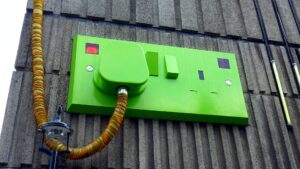
How To Avoid Greenwashing—No Matter What You’re Marketing
What is greenwashing? It’s getting a big, green checkmark for an eco-effort that maybe isn’t as meaningful as it seems. It’s when a business takes
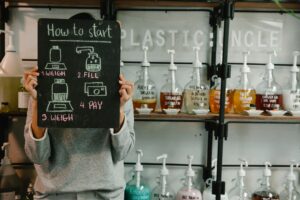
Green Guide: How to Open a Zero Waste Store
In our fast-paced, consumption-driven society, convenience is king. And it comes heavily packaged. While vacuum-sealed avocados and the dreaded box-within-a-box-within-a-box may make great viral photographs,

What does Sustainability Mean? Tips to run a low-impact business
Sustainability is becoming increasingly important. Not only for the environment but also for business! Businesses have the power to make a difference when it comes
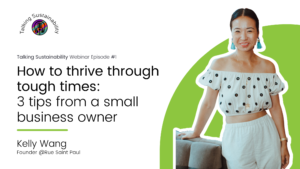
How to thrive through tough times: 3 tips from a small business owner
2021 brought about many new and exciting things, one of them being our new webinar series, Talking Sustainability! Here, we chat with business owners and industry
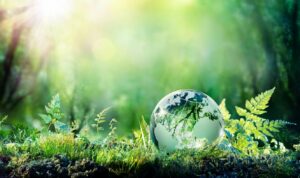
Small Business Forecast: Sustainability in Retail 2022
It’s January, which means many folks are making New Year’s resolutions for 2022. As individuals, we may resolve to live healthier or spend more time
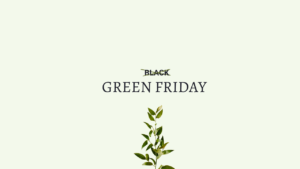
6 Ways Small Businesses Can Support Green Friday (Without Closing!)
Black Friday marks the unofficial start of the holiday shopping season in the US and many other countries. In recent years, retailers have begun slashing
